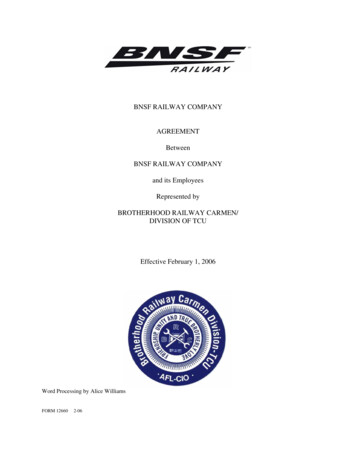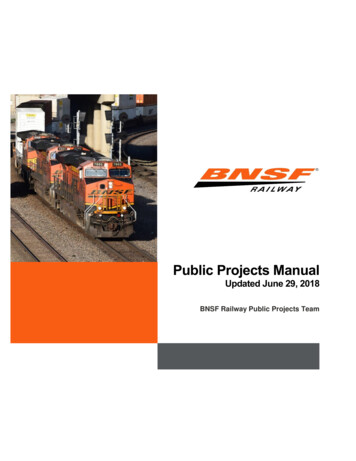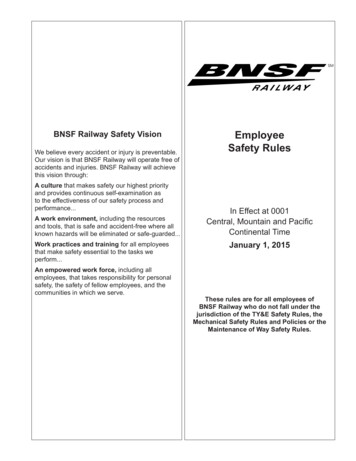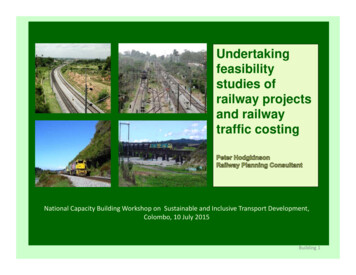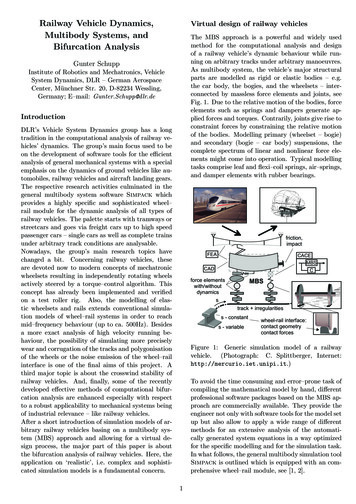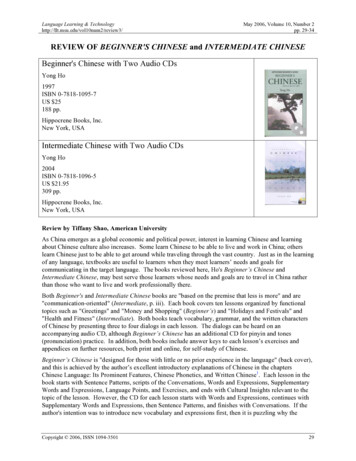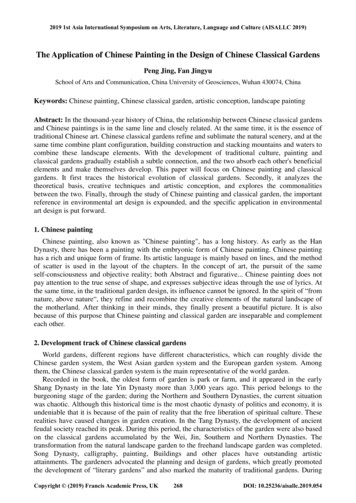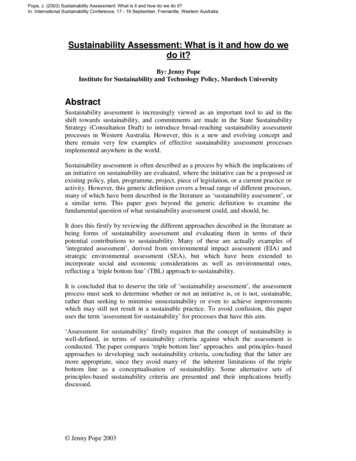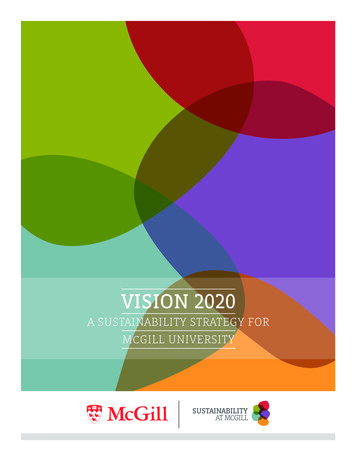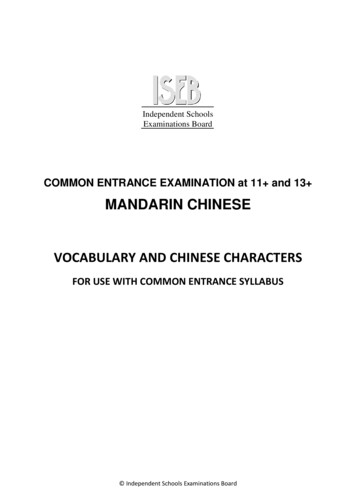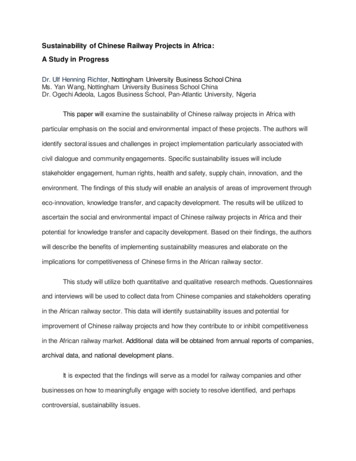
Transcription
Sustainability of Chinese Railway Projects in Africa:A Study in ProgressDr. Ulf Henning Richter, Nottingham University Business School ChinaMs. Yan Wang, Nottingham University Business School ChinaDr. Ogechi Adeola, Lagos Business School, Pan-Atlantic University, NigeriaThis paper will examine the sustainability of Chinese railway projects in Africa withparticular emphasis on the social and environmental impact of these projects. The authors willidentify sectoral issues and challenges in project implementation particularly associated withcivil dialogue and community engagements. Specific sustainability issues will includestakeholder engagement, human rights, health and safety, supply chain, innovation, and theenvironment. The findings of this study will enable an analysis of areas of improvement througheco-innovation, knowledge transfer, and capacity development. The results will be utilized toascertain the social and environmental impact of Chinese railway projects in Africa and theirpotential for knowledge transfer and capacity development. Based on their findings, the authorswill describe the benefits of implementing sustainability measures and elaborate on theimplications for competitiveness of Chinese firms in the African railway sector.This study will utilize both quantitative and qualitative research methods. Questionnairesand interviews will be used to collect data from Chinese companies and stakeholders operatingin the African railway sector. This data will identify sustainability issues and potential forimprovement of Chinese railway projects and how they contribute to or inhibit competitivenessin the African railway market. Additional data will be obtained from annual reports of companies,archival data, and national development plans.It is expected that the findings will serve as a model for railway companies and otherbusinesses on how to meaningfully engage with society to resolve identified, and perhapscontroversial, sustainability issues.
INTRODUCTIONTransport is a vital sector in the African economy, playing a crucial role in the pursuit ofpoverty eradication and sustainable development as it increases the access of businesses andconsumers to goods and services and provides the means for emerging markets to integrateinto the global economy.Amba and Danladi (2013) highlighted in their research that transport is one of the indicesused in assessing the economic development of a country. Also, Salim (2003) and Lingaitiene(2006) noted that the advancement of any country depends on the development of its transportsystem. The rail transport contributes to the socio-economic development of Africa continentsas it facilitates access to markets, jobs, health care, education and leisure activities. Olievschi(2013) reported that rail transportation has played a crucial role in economic development as itsupports low cost movement of freight and passengers and contributes to the growth of miningand agriculture.Railway sustainability is understood to mean the development of a railway system thatcaters to the travel needs of society without putting their quality of life in jeopardy in theimmediate or distant future. Sustainable transport systems align economic growth with socialand environmental priorities as it provides the physical networks and services upon which anation depends.The development of sustainable rail transport which actually meets the mobility andaccess desires of African people and businesses and at the same times reduces or eradicatesgreenhouse-gas emissions is the goal of every African head of government. Ongoingimprovement of railway systems in Africa will facilitate the transportation of goods and rawmaterials, boost tourism, enhance trade and generally improve standard of living of thepopulace.Inefficient and inadequate railroad transport contributes to the high cost of doingbusiness and stifles sustainable development in the African continent. There are many reasons
for the failure of the African rail system to measure up to that of developed countries: Thegovernment has given high priority to road transportation, limited financial resources haveblocked funding of railway projects, good railway expertise is in short supply, and politicalconflicts and natural disasters have created barriers.Reports delivered at the 2014 Africa Sustainable Transport Forum (2014) held, inNairobi, Kenya, concluded that the African continent faces numerous challenges when it comesto sustainable transport. Despite the goals of sustainable and inclusive transport systems indeveloping countries, the lack of a strong political and economic infrastructure and affordableservices have been major obstacles to the development of the Africa continent. The challengefor African government is to create a sustainable rail system that will serve the transportationneeds of individual firms and society that at the same time protects the quality of life for futuregenerations.According to the African Development Bank, the majority of Africa’s railways are in a badstate and need investments in the billions of dollars to maintain rail tracks and signalingsystems, most of which were constructed during colonial years to connect mines and othernatural resources to seaports.Deutsche Bank estimates that about US 50 billion investment is required in Africa toconstruct 4,000km of Greenfield railway lines to fully exploit its iron reserves (AfricaDevelopment Report, 2014). As African governments and their development partners seek tosecure safe, adequate, and affordable railway systems, they are still faced with majorchallenges (as noted in the Africa Review Report on Transport, 2009): unsuitable nationalpolicies; limited implementation of national, sub-regional, and regional agreements; poorly builtand maintained railway networks; inadequate human and institutional capacity; negative effectson the natural environment; poor railway safety and security; poorly developed railwayinformation systems; and limited financial resources.
Chintu and Williamson (2013) included environmental and labor concerns as one of themajor problems confronting State-Owned Enterprise (SOE) in Africa, a choice based onobservations of the lax nature of enforcement of environmental standards, concerns about weakenvironmental standards, and poor labour relations in China. This focus of our research,therefore, is to examine the sustainability of Chinese railway projects in Africa with particularemphasis on the social and environmental impact of these projects.CHINA’S ENGAGEMENT WITH AFRICA IN THE RAILWAY SECTORChina’s investment in Africa has a long history. Mohan and Power (2008), however,noted that the China–Africa relationship was born out of demand and supply considerations, notpolitical and economic affinities. The Chinese quest for African resources and markets wasreciprocated by the African quest for Chinese products and markets (Zeleza, 2014). Chinesehunger for resources provided the motivation for investment in Africa (Bohlund, & Orlik, 2015).The construction industry, a backbone of the Chinese economy, has historically beenlargely state-owned. However, the increased privatization of some state-owned enterprises andthe recent surge of private firms has diversified the market (Center for Chinese Studies, 2006).According to the report of Centre for Chinese Studies, Chinese firms have become an importantplayer in the construction sector in Africa.China’s entrance into the African market began with the construction of TanzaniaZambia railway in the 1970s, and this symbolized China’s contribution to Africa economicdevelopment (Corkin, Burke, & Davies, 2008). It was estimated that by the end of 2006, 800Chinese firms were active on the African continent, engaging in various sectors, mostlyconstruction and infrastructure (Corkin et al.).According to the German newspaper Der Spiegel, some 2,000 Chinese firms are inAfrica, with the majority involved in roads and rail construction. In the Democratic Republic of
Congo (DRC), two Chinese construction firms and a copper mining firm, all state-owned, signeda US 9 billion contract for the construction of rail and road networks (Nirit, 2014).China’s investments in Africa fall into four economic categories: Large Private Enterprisewith close ties to government; State Owned Enterprise (SOEs); Small and Medium Enterprises(SMEs); and Independent Chinese Entrepreneurs (Zeleza, 2014). According to China’s ImportBank, about 800 Chinese firms were in Africa as of 2006, of which approximately 85% wereprivately owned. In 2009, that number grew to 2000 and by 2011 there were about 4,600Chinese firms in Africa (Shinn & Eisenman, 2012).By 2004, Chinese investments in Africa were present in finance (20%); construction(16%); manufacturing (15%); business and lending services (5%), and other sectors 13%(Zeleza, 2014). By 2007, the value of construction contracts won by Chinese firms in Africaamounted to US 30 billion (Dent, 2011).In 2007, in a bid to promote investment in Africa, the Chinese government created theChina-Africa Development Fund (CADF), and created banks which included ChinaDevelopment Bank, China Export Import Bank, and China Agricultural Bank.Although there have been several projects embarked upon by Chinese SOEs in theirrelations with Africa, our focus in this literature review will be the sustainability of the Chineserailway project. In recent years China has contributed significantly to Africa’s economic growthboth in terms of trade and large scale infrastructure projects (e.g., the rehabilitation of the 840mile Benguela railway line connecting Angola’s Atlantic Coast to the Democratic Republic ofCongo and Zambia [Eigen, 2012] and the expansion of the East Africa railway which toconnects Kenya, Ugandan, Rwanda and South Sudan).In Libya, the China Railway Construction Corporation (CRCC) won two contracts in 2008with a combined value of US 2.6 billion to build the rail connection from the east to the west ofthe country. In January 2009, the China Civil Engineering Corporation signed a US 805 millioncontract with the Libyan government to build 172km of railway lines in the North Africa country.
In September 2012, the China Railway Construction Corp. (CRC) signed a US 1.5 billioncontract for the rehabilitation of a railway system in Nigeria (Cottie, 2014).The majority of the rail systems in Africa have their root in the early 20th century duringwhich the European colonial power built railways to aid military movement and thetransportation of goods produced in the mining and farming operations (Africa DevelopmentBank, 2015). After the attainment of independence, the railway networks were broken up.The Africa Development Bank (2015) report highlighted major drivers of railwaydevelopment in Africa: The need for better and more integrated logistics Increased demand in transportation due to the growth of Africa economies The need to provide new urban mass transport The need to build high capacity infrastructure capable of handling mining in bulkvolumes. The need to provide access to the sea with capacity and reliability.Strengths contributing to railway development in Africa (Africa Development Bank, 2015) Increase in the African integrated trade Increased environmental and social sensibility Direct and indirect creation of jobs Better control of urbanization Becoming more attractive for freight transportation.Other benefits of using railway include reduction of road casualties and related costs, farless air pollution than other modes, and less noise pollution than road modes.Chintu and Williamson (2013) pointed out that there have been concerns about theoperation of Chinese firms in Africa in terms of environmental and labour issues. The leniency inenvironmental laws in China and lack of adequate labour laws in hosting countries were said to
be responsible for these problems. In some instances, Chinese firms are known to employ moreof their own citizens than the citizens of their host countries.However, the much-welcomed development was offered by Schneidman (2014, n.p.)“Chinese officials are recognizing the need to participate more actively in the Africancommunities in which invest. In fact, while corporate social responsibility is still a new conceptfor many Chinese companies, it received attention in the 2013 report on China-Africa Tradepublished by the Chinese Academy of International Trade and Economic Co-operation(CAITECH)”CHINA’S ENGAGEMENT WITH NIGERIA IN THE RAILWAY SECTORThe growing trade relationship between China and Nigeria is an indication that bothcountries have economic complementarities (Foster Butterfield, Chen, & Pushak, 2008;Oyeranti, Babatunde, & Ogunkola, 2011). Nigeria is a resource-rich country with inadequatetechnology or infrastructure and China is in dire needs of resources (raw materials) to assist itsindustries. The implications for China–Nigeria trade relations is that primary products are movedto China and finished products are imported to Nigeria, particularly the finished goods whichNigeria lacks the technological know-how to produce (Akongbowa, 2008).Zelesa (2014) perceives mixed reactions to Sino–Nigeria relations. The relationship isseen in some quarters as new colonialism in Africa; exploitation without transparency or goodcorporate citizenship (Chintu & Williamson, 2013). However, in reality, the reverse is the caseas China’s foreign policy is based on socialism that believes in equal justice for all. As claimedby Mohan and Power (2008), China’s relationship with Africa are not based on giving politicaland economic conditionalities to Africa; rather, it is based on supply and demandconsiderations. In other words, China’s contractors in Africa disregard ideology but attachimportance to political risk and stability in host countries (Oyeranti et al., 2011).
In their quest for resources and their bilateral relations with African countries, China hasengaged in what is tagged “resources for infrastructure.” This implies the provision ofinfrastructure such as roads, bridges, and rails in payment for resources acquired from Africa.There have been mixed reactions to this plan. For example, in the case of Nigeria, an inquiryinto the oil block auctions in 2007 shows that the Nigerian government disapproved the oil-forinfrastructure approach because they were aware that some of China’s State-OwnedEnterprises (SOEs) did not deliver on previously promised infrastructure projects (Egbula &Zheng, 2011).In the area of railway construction, the dominant company in Nigeria is the China CivilEngineering Construction Company (CCECC), with contract awarded for the rejuvenation of theNigerian rail systems (Ogunkola, 2008), the modernization of the Nigerian one-track rail line to astandard gauge rail project (Siaka, 2009), amongst others. Notably, in October 2006, theNigerian government signed a US 2.5 billion loan facility with China, with a substantial portionused for the financing of the railway system refurbishment (Emeje, 2006). The first phase of thecontract included the 1,215 kilometre double track standard gauge line from Lagos (southwest)to Kano (northwest) with a branch in Minna and Abuja (Rindap, 2015). Upon completion it isexpected that the railway modernization and expansion project will have the capacity to operate36 trains per day from Lagos to Kano (Rindap, 2015). Therefore, it can be argued that Chinahas indicated a strong financial commitment to the Nigerian rail sector, especially the Lagos Kano rehabilitation project, the Abuja Rail Mass Transit System, amongst others (Oyeranti et al.,2008).
RESEARCH DESIGN AND METHODOLOGYOur approach is based on findings from a 2014 study by Network for BusinessSustainability (NBS) Canada, “A dialogue about Sustainability in Canada’s Railway Sector”(NBS, 2014). The report identified the most relevant sustainability issues relating to the sectoras Emissions, Safety, Ecosystem and other environmental issues, Employees,Stakeholders/Communities, Climate adaptation, Governance/ethics and Customers. Using theeight themes, we developed questionnaires which will be administered to the followingstakeholder groups: Community and Government Industry Partners Employees Climate Change Specialists CustomersThe main objective of this work is to assess the applicability of these eight sustainabilityissues to Chinese railway projects in Africa, and propose suggestions on how to improve thesocial and environmental performance of the projects. The data gathered from Chinese andAfrican stakeholders using questionnaires and personal interviews data as well as informationobtained from annual reports of companies, archival data and national development plans willcontribute to an understanding of how such projects may advance or inhibit competitiveness inthe African railway market.The study will focus on Chinese railway projects in Kenya (East Africa), Ghana andNigeria (West Africa), and South Africa.Conclusion
Despite the negative effect of rail transport on environmental human health (such as airand noise pollution, destruction of forests and wildlife habitat, land degradation through soilerosion of drainage system and geological formations associated with the construction ofrailways) railway still plays a vital role in the development of African economies by transportingfreight and passengers at low cost and enabling the growth of the mining and agriculture.African nations need to develop policies that strengthen their ability to monitor andenforce capabilities labour, safety, and environmental protections (Shinn & Eisenman, 2012) byensuring that Chinese firms involved in the construction of railways in Africa adopt globalstandards and abide by the rules of the International Labour Organisation. The Africangovernment should create an enabling environment that will encourage investment in thecontinent. Sustainable transport development thrives best in an environment of goodgovernance, peace, and security.The findings of this study will provide practitioners with assessment tools for theevaluation of railway projects in Africa and offer effective ways for stakeholders to eradicate orminimize the environmental impact associated with the construction and maintenance ofrailways, including issues on staff welfare, community development, and stakeholderengagement. The study will also identify social corporate responsibilities (community services)that should be adopted to enhance relationships with host communities. It is expected that thefindings will serve as a model for railway companies and other businesses on how tomeaningfully engage with society to resolve identified, and perhaps controversial, sustainabilityissues.
ReferencesAfrican Development Bank Group. (2015). Rail infrastructure in Africa, financing policy options.Available ents/Events/ATFforum/Rail Infrastructure in Africa - Financing Policy Options - AfDB.pdfAfrica Sustainable Transport Forum. (2014, October). Full Meeting Report. ASTF InauguralForum. Nairobi, Kenya. Available athttp://www.unep.org/Transport/astf/pdf/ASTF FullReport.pdfAkongbowa, B. A. (2008, June). Nigeria-China economic cooperation: Conceptualization,contending issues and prospects and its implications for the West African sub-region.12th EADI General Conference, Global Governance for Sustainable Development,Geneva.Amba, D., & Danladi, J. (2013). An appraisal of the Nigerian transport sector: Evidence from therailway and aviation sub-sectors. Journal of Economics and Sustainable Development,4(10), 161-171.Bohlund, M., & Orlik, T. (2015, June). Road to Africa closes infrastructure gap, adds debt risk.Bloomerg Brief. Available ites/2/2015/07/SC 062615-OBOR.pdfCenter for Chinese Studies, Stellenbosch University. (2006). China’s interest and activity inAfrica’s construction and infrastructure. Available tion.pdfChintu, N., & Williamson, P. J. (2013). Chinese state-owned enterprises in Africa: Myths andRealities. The Daily Sabbatical/Ivey Business School, 2. Available -and-realities/35745/0Corkin, L., Burke, C., & Davies, M. (2008). China’s role in the development of Africa’sinfrastructure. Documents de travail du SAIS dans African Studies, 04-08.Cottie, E. (2014). Chinese Construction Companies In Africa: A Challenge For Trade Unions.Equal Times. Available at paniesin?lang en#.Vt3NrJwrLIUDent, C. M. (ed.). 2011b. China and Africa Development Relations. London and New York:Routledge.Egbula, M., & Zheng, Q. (2011). China and Nigeria: A powerful south-south alliance. WestAfrican Challenges, 5.Eigen, P. (2012). Is China good or bad for Africa? Special to CNN. Available at:from /is-china-good-or-bad-for-africa/Emeje, A. (2006, March 17). China to invest 2 billion in Nigeria. LeadershipFoster, V., Butterfield, W., Chen, C., & Pushak, N. (2008). Building bridges: China’s growing roleas infrastructure financier for Sub-Saharan Africa. The International Bank forReconstruction and Development/The World Bank. Trends and Policy Options, 5.
Lingaitiene, O. (2006). Application of a general model of multimodal transportation in logistics.Transport and Telecommunication 7(1), 92-96.Mohan, G., & Power, M. (2008). New African choices? The politics of Chinese engagement.Review of African Political Economy, 35(115), 23-42.NBS. (2014). A dialogue about sustainability in Canada’s railway sector. Network for BusinessSustainability, Canada. Available at http://nbs.net/wpcontent/uploads/RAC Civic Dialogue.pdfOgunkola, O. E. (2008). Nigeria-China trade and economic relations. Ibadan: Nigeria AfricanResearch Consortium (AERC) Publishers.Olievschi, V. N. (2013). Rail transport: Framework for improving railway sector performance inSub-Saharan Africa. The World Bank, Documents and Reports. Available ay-sector-performance-sub-saharan-africaOyeranti, G. A., Babatunde, M. A., & Ogunkola, E. O. (2011). An analysis of China-Nigeriainvestment relations. Journal of Chinese Economic and Foreign Trade Studies, 4(3),183-199.Rindap, M. R. (2015). An assessment of Nigeria-China economic relations from 1999-2014.International Journal of Arts and Humanities, 4(1), 18-30. Available athttp://afrrevjo.net/journals/ijah/Vol 4 no 1 art 2 Rindap.pdfSalim, I. (2003). Security aspects of multimodal transport. In Proceedings of the Expert Meetingon the Development of multimodal Transport and Logistics services, 24-26.Shinn, D. H., & Eisenman, J. (2012). China and Africa: A century of engagement. Philadelphia,PA: University of Pennsylvania Press.Siaka, M. (2009). How tidy is Nigeria-China relations? Available -nigeria-china-relations-1/Schneidman W. (2014). Are Chinese Companies Retooling in Africa? Brookings. Available -schneidmanUnited Nations Economic Commission for Africa: Sustainable Development Report on AfricaManaging Land-Based Resources for Sustainable Development. (n.d.). Available velopment-report-africa-iZeleza, P. T. (2014). The Africa-China relationship: Challenges and opportunities. CanadianJournal of African Studies/La Revue canadienne des études africaines, 48(1), 145-169.
A Study in Progress Dr. Ulf Henning Richter, Nottingham University Business School China Ms. Yan Wang, Nottingham University Business School China . China's investment in Africa has a long history. Mohan and Power (2008), however, noted that the China-Africa relationship was born out of demand and supply considerations, not
